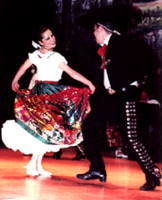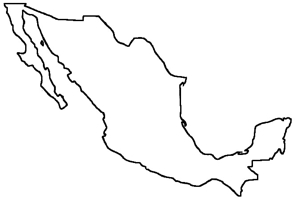
|
The Society of Folk Dance Historians (SFDH)
Mexican Dance
[
Home |
About |
Encyclopedia |
CLICK AN IMAGE TO ENLARGE
|

|
HISTORY OF FOLK DANCE IN MEXICO
 Information: Mexican folk dancing is one of the most eye-catching international dance forms around. With a stunning display of colors and upbeat musical accompaniment, folk dancing south of the border signifies a good time. Like many foreign dance styles, Mexican folk dance has been shaped and influenced by the country's history, including the Mexican Revolution and the Spanish Colonial Period. Several cultural backgrounds are represented in any given folk dance performance, and knowing the history can give you a better understanding of the various influences.
Information: Mexican folk dancing is one of the most eye-catching international dance forms around. With a stunning display of colors and upbeat musical accompaniment, folk dancing south of the border signifies a good time. Like many foreign dance styles, Mexican folk dance has been shaped and influenced by the country's history, including the Mexican Revolution and the Spanish Colonial Period. Several cultural backgrounds are represented in any given folk dance performance, and knowing the history can give you a better understanding of the various influences.
Folk dance always has been rooted in celebration, be it at a party, a religious ceremony, or a festival. Dance is used for the purpose of honoring the country's unique heritage, while also recognizing both the joy and hard times of the Mexican life. Folk dance's origins in Mexico are found in Meso-American times, in which natives performed dances to appeal to the Mayan and Aztec gods. Later on, when the Spanish arrived during the 16th century, European dances, such as court dancing and Polka, were infused with the indigenous choreography. Today, there are three forms of Mexican folk dance still used:
- Danza, the native ritual dance used for religion and community.
- Mestizo, a Western-influenced dance that has been combined with indigenous form, that is the type of dancing usually presented at Mexican Independence Day celebrations and other festivals and holidays.
- Bailes Regionales, the regional dances that are created by individual communities. As a tourist in Mexico, you often will find these in community theater and dance studio performances.
TYPES OF DANCING
Within the three genres of folk dance, there are many dances that are popular and well known. Many are taught to school children in preparation for a particular holiday, while others are taught in dance studios or as part of a Mexican folk dancing team. These dances are not limited to within Mexico's borders; many Mexican-Americans enjoy participating in such dance troupes, and Europe also embraces Mexican dancing.
Jarabe Tapatío
You may not recognize the Spanish name, but you surely know the dance. The Jarabe Tapatío, also known as the Mexican Hat Dance, is the most popular folk dance to ever spring out of Mexico. Considered to be the nation's official dance, many learn this as children and continue to dance it at festivals and birthday parties. A flirtatious courting dance, the Jarabe Tapatío first gained popularity when the great Russian ballerina Anna Pavlova incorporated it into her repertoire after visiting Mexico in 1919, and the dance remains a favorite with Mexican audiences today. The female costume worn during this dance is the "china poblana," an early traditional style of women's dress that includes a white fringed blouse, a skirt, and a shawl. The male costume is an ornate "charro" (cowboy) suit decorated with silver buttons. It is the same apparel worn by mariachi band members.
La Danza del Venado
Created by the Yaqui Indians of Mexico, La Danza del Venado reenacts a deer hunt, complete with dancers wearing masques to represent the deer and the hunter.
El Baile de los Viejitos
This dance of the old men was originally written to mock the Spanish upper class. The men traditionally dance with machetes and masks, while the women move with fans.
Concheros
This is a religious dance that portrays some of the rituals that were conducted by the pre-Columbian Aztecs. Named after a stringed instrument constructed from an armadillo shell, the dance pays homage to the four elements of earth, air, fire, and water. The Concheros is a showy dance featuring ceremonial processions, feathered costumes, floral decorations, incense, and drums.
Danza de los Voladores
Danza de los Voladores (Dance of the Flyers) is a unique style of dance where the dancers start out on top of a high pole and then hang upside down tethered to ropes attached to their ankles as they are lowered to the ground while circling the pole. Also known as the Mexican Pole Dance, this ritual dance is traditionally performed by five men: the musician, who remains at the top of the pole playing a flute and drum, and the four "flyers."
Son Jarocho
This dance form began in Veracruz. Son Jarocho events are known as fandangos. ("La Bamba" is a song that originated here.) Its popularity has spread well outside of Mexico. Mexican dancing here is characterized by a combination of Spanish, African, and Caribbean rhythms as well as by a flurry of steps called "zapateados" that have Flamenco characteristics. The female costume has a combination of Spanish and Cuban influences, such as Spanish shoes, flowers in the headpiece, a lace top, and an apron. The male costume in this dance is influenced by Cuban fashion and includes a shirt called a "guayabera" with four large pockets.
Matachines
This ritual dance is performed during Catholic holy days throughout the year in honor of various saints. The dance originated as a morality play to depict the battle between Christians and pagans, and this theme is carried on today. Dancers of all ages, from young children to seniors, dance to drums and carry rattles or swords while wearing elaborate costumes with fancy headdresses. In this exercise, men loudly bang together matchetes, sending sparks flying, and form matchete arches under which the women dance and hold their arms high, twist, bend, and slyly shrug their shoulders. This Mexican dance dates from the 8th century when the Moors conquered the Spanish and also incorporates Flamenco influences. The women wear a small flower print ranchera style outfit and employ a colorful Huichol fan. The men in the Matachines dance wear white pants, a bandana, and a traditional white shirt under a colored shirt.
Parachicos
This traditional dance is performed daily during a festival that takes place every January in the Mexican town of Chiapa de Corzo. The dancers shake maracas and wear masks along with fluffy headdresses and brightly-colored serapes as they lead a procession through the city's streets while carrying statues of their patron saints.
COSTUMING
Women are traditionally dressed in round, floor length skirts that are vibrant in color and design. A floral print or any sort of specific stitching on the dress may signify a certain region or style of dance. A flouncy or fringed blouse is also the norm. Men usually dress in modified cowboy suits, much as you would see a mariachi player wear, but men also can wear linen shirts, dark pants, and boots. The dancers are accompanied by a flute and drums.
DOCUMENTS
- Legends and Dances of Old Mexico, a book.
- Mexican and New Mexican Folkdances, a book.
- Mexican Regional Dances, a book.
- Mexico, a country.
By Tamara Warta on the Internet
combined with other Internet material
Printed in Folk Dance Scene, September 2015.
This page © 2018 by Ron Houston.
Please do not copy any part of this page without including this copyright notice.
Please do not copy small portions out of context.
Please do not copy large portions without permission from Ron Houston.